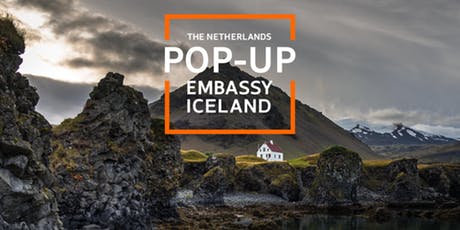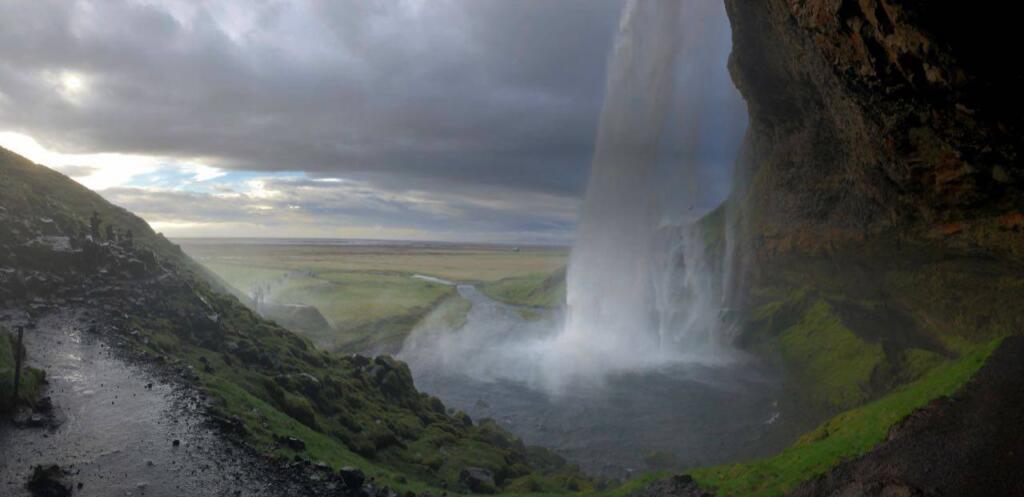Reykjavik, Iceland: Roundtable on Sustainability & Circular Economy
May 22, 2019
During the week of April 29th until May 3rd the embassy of the Kingdom of the Netherlands in Oslo has organised a ‘pop-up embassy’ in Iceland. This means the offices have been moved to Reykjavik and the embassy has set up shop as if there would have been a Dutch embassy in Iceland. During that week, consular services were provided for, political bilateral meetings were initiated, but also, and at the same time, several cultural and sport related activities are being were organized as well. The main event during the week was the round table on circular economy. The overall goal was to strengthen the bilateral relations between Iceland and the Netherlands and create a solid and fruitful basis for further collaboration.

Background Iceland
Prior to the events, site visits were organised to municipal recycler SORPA and national energy company Landsvirkjun.
Iceland has 360.000 inhabitants of which 2/3 live in Reykjavik. Iceland receives roughly two million short term visitors per year, which is equivalent to 25.000 permanent habitants.
Landfill is still very important (space is not an issue in Iceland) but recycling is growing. Action plans and investments for plastics and organics are being rolled out. Uniformity in Iceland in collection systems still have room for improvement.
All of Icelands energy is renewable and comes roughly 50-50% from hydropower and geothermal initiatives. The drive to go for other renewables is not urgent. In the long term however, due to climate change, Iceland will run out of Glaciers and hydropower. Iceland’s unlimited geothermal resources might play a role in the energy transition of Europe. Could Iceland become a hub for large scale hydrogen production connected by pipes or ships to Rotterdam/mainland Europe? Hydrogen is an energy carrier and building block for chemistry. How can Iceland make its transition to a circular economy?
Roundtable on Circular Economy
The main event during the week was the roundtable on Circular economy organised by the Embassy, the City of Reykjavik, the City of Rotterdam, and Holland Circular Hotspot.
Mr. Freek van Eijk from Holland Circular Hotspot moderated the programme and set the scene of Circular economy by explaining the concept, the Dutch drive to go Circular and the opportunities it offers for business is various market segments and options for collaboration.
Mrs. Ólöf Örvarsdóttir, Head of Environment and Planning Authority from the City of Reykjavik presented the focus actions of the city. Reykjavik wants to be Carbon-neutral 2040 and has three focus area’s: Transport & energy use, Waste & recycling, Climate change adaptation.
Mrs. Petra de Groene, Director Economic Affairs and Sustainability, City of Rotterdam, and Mrs. Nadia Lopes, Project leader and Circular Economy Advisor, City of Rotterdam, explored the topic of Circular Cities and explained why and how Rotterdam has adopted Circular Economy, both the strategic level and the pragmatic, actionable level on the ground.
Takeaways and findings
- All participants were very motivated and driven to work on sustainability. There was clearly a positive ‘let’s work on this’-vibe and this is perceived as crucial in realizing the transition towards a more circular economy.
- Decisions in procurement are key: 20% of procurement concerns public procurementand municipalities can therefore make a huge difference in pushing the transition towards a circular economy. One way to facilitate this is to focus on sustainable public procurement.
- The relevance of integrating Circular Economy aspects into in policy planning. This requires creativity and an open mindset. We are often insufficiently aware of how financing decisions are being framed towards decision makers: ‘spending’ versus ‘investing’.
- First steps are always the hardest: how can we start? What first steps are needed when it concerns doing business in relation to a circular economy market based approach? Unfortunately there is no ‘one size fits all’ answer, but when it concerns setting up a Circular Economy strategy a broad range of stakeholders should preferably be involved: government, knowledge & research institutes, the private sector, start-ups as well as multinationals.
- The definition of ‘waste’ versus ‘raw material’ is often interpreted differently and has a direct influence on its perceived value. Definitions might also have to be changed as what once was waste, might be a valuable raw material in the future. For example coffee grind which is now used to grow mushrooms.
- The importance of setting a roadmap: dedicate specific focus areas (potentially with low hanging fruit), don’t get stuck on rules and regulations which have worked for a linear economy, get the private sector involved and stimulate public-private partnerships. At a city level the role of government can entail the coordination and initiative of organizing CE related events, (helping) setting up a network, creating incentives for financing start-ups, speeding up the permitting process for CE related products and services, creating opportunities and facilitating experimentation.
- The collaboration between cities – on a national and international level, exchanging best practices and lessons learned, creates added value and prevents us from reinventing the wheel.
Break-out sessions
The Break-out sessions of this afternoon focused on consumption goods: stimulating less and longer use of products and materials, reuse and recycling – moderated by Nadia Lopes, construction and infrastructure: stimulating circular building – moderated by Petra de Groene and green sources: collection and use of green waste, organic waste – moderated by Holland Circular Hotspot’s director Freek van Eijk.
Below a brief description of the outcome and discussion points addressed at the different tables:
Table ‘Consumer goods’
- Implementing a regulatory framework is crucial and this should be embedded in all levels. Government needs to step up and ideally all relevant stakeholders should be involved in the process of developing and implementing rules and regulations. A good example are requirements regarding product labelling.
Table ‘Construction & Infrastructure’
- On an overall level, in order to move towards a more circular economy there is a need for: data collection and more cooperation among stakeholders.
- Proof of concept is key: investors and architects need to be convinced that it is possible to build in a different and more sustainable way.
- The effect of decision making: the potential impact on the climate of the building industry when choosing between importing construction material or using locally produced in Iceland.
- Stretching the life span of buildings: construct flexible and therefore more sustainable For example power plants could be built in such a way that they can be adjusted when needs change, this will extend their life time.
- Indicating opportunities in the leftovers of production: we are missing out when it concerns the focus on what to do with leftovers of production. For example hot water & excess steam of power plants. Integrated planning could also include theses potential linkages in the construction phase of buildings, although they might not seem relevant at the current time.
- Take energy efficient building to the next level: energy efficiency in the built environment is on the agenda, but a lot is still to be gained in the construction phase and usage ofmaterials.
- Building permitting process should take the plans regarding the disposal of material waste into account.
- Financial incentives and green loans are potential kick starters: implementing further financial incentives could work as a motivator. Also the element of competition could be beneficial. For example: from this fall on many schools in Reykjavik will be included in a ranking concerning their energyconsumption and this will create competition in a positive way.
Table ‘Green sources’
- An estimated 1/3 of all food produced globally is lost or goes to waste. Food waste has significant environmental, economic and social costs. Climate change can be mitigated through the reduction of food loss and waste.
- The biggest food waster is the consumer. About 50% of all the food wastage happens at people’s homes. But also occurs during industrial processing, distribution and consumption.
- The whole value chain needs to be taken into account as this is not just a waste of money, it is especially a waste of valuable resources that were needed to produce and transport the food.
- Value in the food waste stream in Iceland is concentrated in household waste, lam & fishery industries and restaurants. The amount of good food that is wasted in Iceland and the Netherlands adds up to billions per year. Solutions for reducing food waste are within easy reach and reductions are possible. Efficiency measures and innovation in the production process can create a big impact.
- Identify potential areas of development and ‘low hanging fruit’: the transition to a circular economy takes time and starting with certain focus sectors could be a practical approach.
- Generating business opportunities in food waste: examples of Iceland: the success story of the year-round “ Ugly tomato” farm and restaurant. The tomatoes are grown annually using geothermal energy from a nearby hot spring and zero pesticides, but more importantly the farm’s ‘ugly tomatoes’ have become a star ingredient in soup and fresh pasta and now also is tourist attraction. Another example is Ugly Potatoes, the first Icelandic potato chips and are made from B class potatoes that would otherwise been disposed of.
- The use of standardized labels to reduce food waste: e.g. food expiration labels now vary (for instance ‘best if used by’ and ‘use by’). Manufacturers should step up to help consumers and to reduce food waste. The use of standards increases efficiency and helps reduce unnecessary waste by harmonizing requirements and optimizing production processes, quality and enhancing environmental performance.
- The issue of food waste is beginning to attract more attention but food waste campaigns could further contribute to raising awareness and instill more sustainable practices regarding food waste. Environmental labelling can be used by organizations to communicate about their environmental impact so consumers can make informed choices.
- When hoping to minimize the amount of waste you could look for savings and reducing the costs of disposal of organic waste and/or increase the tipping fees for regular household waste.
- Role of government in incentivizing, taxation and setting the example is crucial!
Next steps
The interest of the Icelanders was huge. A lot more best practices existed than they were aware of, and there was an appetite for exploring the inspirational examples from the Netherlands. Also the idea of a local circular hotspot caught traction. Reykjavik, the national ministry and environment and local industries are investigating if they can set it up. An idea that is very welcome to HCH and fits well in the broader interest in the Nordics to strengthen circular collaboration.
In all it was a great and warm event full with interaction and potential for follow-up.


